Classical Guitar Left hand exercises
One of the biggest challenges facing people who play the classical guitar is moderating the amount of pressure used to fret a string. Too much pressure and you're wasting effort and energy and slowing down your playing; too little and you end up with fret buzz.
I’m getting a lot of messages from people coming here because they want to learn to play guitar as part of worship. If this is you, you might want to join Aaron Anastasi’s programme. Aaron is a musician and a worship leader. He put together a step by step programme for aspiring Christian musicians. If you're interested, you can use the exercises and advice in learn-classical-guitar-today to develop your finger strength and dexterity and Aaron's lessons to work on strumming and worship music.
CLICK HERE TO LEARN WORSHIP GUITAR !!
The solution lies in increased awareness!
But how do we achieve this increased awareness ...
The classical guitar left hand exercises below are great for helping to develop this 'awareness' and for developing a relaxed left hand. The purpose of playing through these exercises is to internalize the approach used in order that you might use the very same approach to develop your awareness of left hand tension and as an approach to resolve problems with left hand tension.
Whatever you do, play it slowly. Speed will be much easier to build once everything else is in place. Awareness is built by repeating, slowly, and with care and total concentration, a series of very carefully enacted movements. In a sense, it's becoming a bit zen about your playing and the awareness of your body, your feelings and your fingers that you bring to your classical guitar playing. By moving slowly through these classical guitar left hand exercises and other such exercises that you might work out, you teach your fingers how you expect it to move and to behave, but it also develops your confidence in your ability to guide and control the movement of your fingers.
As you work through your own music pieces you will identify places where you are using more pressure than necessary. In these cases slow down and work that particular problem applying the exercise from below that makes the most sense.
The more time you spend on the technical pages on this site the more advice you will get on how to work out your problems and the more experience you will gain in determining where your greatest problems lie and in working out solutions to solve them - this is what building awareness and developing confident control is all about.
Technical Exercise 1. Building Relaxation into Horizontal String Movement
|
STEP 1: Play A with Finger 1 on Fret 5 on the 6th string |
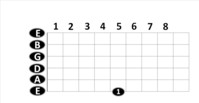 |
If you need a refresher on the names of fingers in classical guitar, click here.
|
STEP 2: Play A sharp by using Finger 2 on Fret 6 on the 6th string. Take a moment to totally relax the previous finger, but without removing it from the string. |
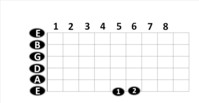 |
|
STEP 3: Play B by using Finger 3 on Fret 7 on the 6th string. Take a moment to totally relax fingers 1 and 2, but without removing them from the 6th string. |
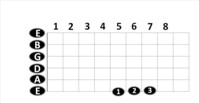 |
|
STEP 4: Play C by using Finger 4 on Fret 8 on the 6th string. Totally relax fingers 1, 2 and 3 but without removing them from the 6th string. |
 |
|
STEP 5: Play C by using Finger 4 on Fret 8 on the 6th string. Totally relax fingers 1, 2 and 3 but without removing them from the 6th string. |
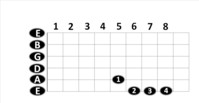 |
|
STEP 6: Play D# sharp by moving finger 2 down to Fret 6 on the 5th string. Totally relax fingers 1, 3 and 4 but without removing them from the string that they are on. |
 |
Continue in this way until you have completed the fretboard and then repeat the exercise on the D (4th) string and A (5th) string. If you're not sure what is meant in the exercise above by 'Fret 5', 'Fret 6' and so on, have a look here for notes on the guitar fretboard.
Below is an excerpt from Francisco Tarrega's Capricho Arabe. It contains a beautiful scale run which provides an provides an excellent opportunity to practice these classical guitar left hand exercises in a real world context.

Technical Exercise 2. Applying fret buzz
Practice the scales provided here by using the buzzing technique in the video. This same technique can be used for any piece of music that you are working on or any scale.
Below is a video by Simon Powis who besides being a highly rated professional classical guitarist also runs an amazing website for classical guitarists.
Technical Exercise 3. Building relaxation into string crossing
Apply the principal of Step 5 and 6 to steadily building further string gaps between the fingers. For example, in the first instance you can move to the string below (the A string in Exercise 5). Thereafter, you can move to two strings below which, if you use the example of Exercise 5, would be the D string and then three strings become, which would be the G string. This is a great exercise for developing finger stretch, but also for working out where you have the biggest problems with respect to string crossing. 3, which combines string buzzing (Technical Exercise 2) with relaxing the finger not being plucked (Technical Exercise 1) particularly useful for string crossing.
Technical Exercise 4. Applying forte and pianissimo
Technical Exercise 4 is very useful for resolving tricky pieces of the music. One of the interesting things about the way that we speak is that when we want to speak loudly we tend to use extra force in our voices. We tend to use the same approach when we play, when we play loudly we tend to use more force in our left hand than when we play quietly. A technique is to play softly and quietly, get as pianissimo as you can and watch as your left hand relaxes. Now try and keep the feeling of relaxation and softness in your left as you play the same classical guitar left hand exercise more loudly.
Okay, now all you have to do is practice these for 5 minutes a day and you will see a steady increase in your finger strength and finger stretch.
CLICK HERE TO RETURN HOME
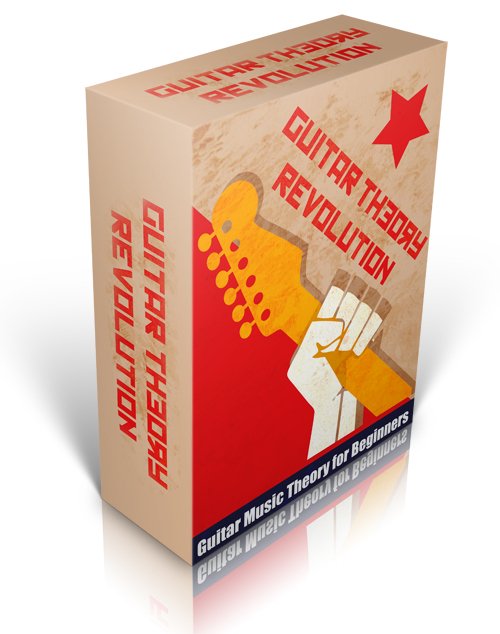
You'll need to go a little deeper into music theory as you proceed. The best online resource for this is Guitar Theory Revolution. It recognises that music theory is very hard for guitarists because music theory has till now been located in the piano paradigm. The Guitar Theory Revolution overthrows the piano paradigm that is holding you back and embraces the attributes of the guitar to unpack music theory. In fact, it goes further and allows you to see that the guitar is one of the best instruments for learning theory.





